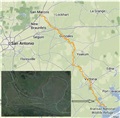Response to "Watch the Start of the Texas Water Safari Trip"
June 12, 2013
by Lynne C. Andrus and Paula Scotney-Castle
Thank you, Terry and Harmon, for your encouraging words before the start of the 2013 Texas Water Safari and the interesting Waterline write-up afterward. We also appreciate the photos of our Texas Water Safari (TWS) team, as teams who finish well behind the top teams seem to get very little coverage. Oh well, it is a race against other teams as well as the clock.
 |
|
|
Race start
|
|
In “the world’s toughest canoe race", where only two out of three teams finish in a low water year, RainDance (#1212) finished Wednesday morning, June 12 after paddling 265 miles in 97.5 hours. Team Captains Lynn Vance (Austin, TX) and HCC member Mark Andrus supported from land, tandem paddlers Lynne Andrus (Austin) and Paula Scotney-Castle (California). We not only functioned well as a team but remain best of friends! Our trek, marked by GPS at 10-minute increments, is overlaid on Google Maps and Google Satellite at www.findmespot.com/spotadventures.
| |
 |
| |
The San Marcos is a
gorgeous river. Here's
a photo between
Luling and Palmetto
Park that tries to
capture some of
her best features.
|
We had hoped for a finish of 85 hours or less as each additional hour compounds the challenge by increasing issues with rest, nutrition, mosquitoes, and in our case weather. For example, we reached the dreaded mile long logjam at night. In addition, instead of the calm bay conditions paddled by the earlier finishers, we faced 15 to 20 knot headwinds, rain, and confused 2’+ seas in the 6 mile open bay finish. Our upright finish in difficult conditions was impressive enough to be posted on the TWS facebook page (#1212 at the 8:37am entry mark) at www.facebook.com/texaswatersafari.
With a somewhat disastrous first day, we fell far behind with one setback after another. In last month’s Waterline article, Terry’s photo captured our frantic back-paddling to avoid a wipeout with the aluminum canoe that pinned. (That’s RainDance in the background – the Kevlar canoe with paddlers with PFDs and wearing blue.) We pulled out into the current to follow the aluminum canoe through and had to use adrenaline and whitewater skills to immediately eddy out and portage yet again.
We were buoyed by the support of friends, family, race volunteers, and spectators. Paula’s husband and children waving us on at different river points was a highlight as well as fellow paddlers along the way. The team was also raising funds for charity that made our efforts something more important than us and thus kept us going. (See www.setonfund.org/canoeingnurses and www.razoo.com/story/Paula-Paddling-For-Pawalsh for more information.)
| |
 |
| |
Lynne and Paula
leaving Staples
checkpoint |
We had an excellent line at Cottenseed and other rapids in the top section. However, we misjudged one of the many strainers below Staples dam. Our gear was well secured but the flip did cost us several snap rivets which we would need for our spray skirt in the bay crossing. Fatigue and frustration contributed to Lynne’s misstep on a large loose boulder at Luling Zedler dam at mile 40. By the time that we realized that her broken foot was not getting better, we had reached mile 85 with most of the portages complete. From there, she could ice and rest the foot while paddling the next 185 miles. Now, back in the real world, Lynne is missing the relative freedom of the canoe as she has been fitted with a boot cast and crutches for six weeks.
In the earlier article, Harmon wrote, “It amazed me once again how many of these paddlers did not know that their stability in rapids is in their paddle.” Many of the TWS paddlers are not skilled at reading currents or bay conditions. Yet, there are many components needed to complete the race (in no particular order):
• Knowledge that you both want and can finish
• Planning with inside knowledge shared by others and experienced first hand
• Appropriate equipment (e.g., reasonable fast, light, & seaworthy canoe; paddles that
support a quarter million strokes; drink & nutrition systems; light system; blister, sun
and bug protection)
• Racing skills
• Portaging skills
• Moving water skills
• Sea kayaking skills
• Skilled team captains
Other than possibly the top teams, few of the TWS teams have all of the above. For instance, we sucked at racing and portaging skills. But our outstanding team captains and the other skills got us through.
After Lulling, we had the expected ups and downs but got more sleep and fewer hallucinations than in our 2012 attempt. We now have the finisher’s patch and plaque and don’t plan to paddle it again. Lynne may consider becoming a race volunteer or team captain role – perhaps even as a photographer following the teams who finish in 80 to 100 hours.
 |
|
 |
|
 |
|
 |
| Bay crossing |
|
Lynne Andrus |
|
Map with a blown up
photo of part of the
logjam |
|
GPS overlay on Google
satellite as we crossed
San Antonio Bay
to the finish |
 |
|
 |
|
 |
Paula in bow lifted
out of the water
by 2 foot chaotic seas |
|
Paula and Lynne just
moments after finish.
Paula’s face says it all… |
|
Mark, Lynne, Paula,
and Lynn at finish |
I'm happy to paddle with folks or talk planning onTWS anytime.
Photographers: Pat Ebeling and Robert Youens.
 |
The racers:
Lynne C. Andrus and
Paula Scotney-Castle |